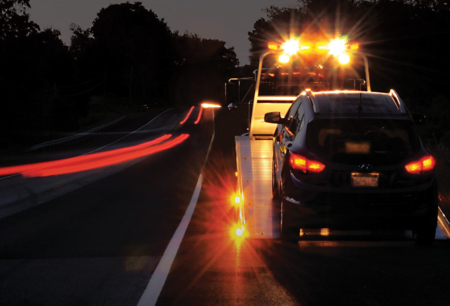Towing operations has many components and operators are put in the face of danger on many occasions on the job.
The following are safe work practices relative to towing operations:
Driver Selection
- Establish a well-defined driver qualification program. This should include written job description and duties. Establish minimum physical attributes required to perform the job (vision, hearing, health history and substance abuse). Additional requirements must be met if subject to CDL Federal and or State Requirements.
- Establish written prerequisites the driver should posses for the job. This should include: level of education, amount of past training, previous driving experience, and degree of driving skill. In the case of Federal Motor Carrier Safety Regulations and or State Safety Regulations, additional training/experience requirements may be necessary. In all cases pre-employment and annual Motor Vehicle Records should be obtained and company standards (written policies) should applied determining acceptable driving standards.
Training
- Establish a written company policy and convey to the applicant driver, during the interview process, that a road test and skills evaluation will be administered. Conduct the test on the equipment the applicant will be operating. Establish a probationary period minimum of 30 days (unless labor agreements require more or less) to evaluate if the driver is meeting written company standards.
- Never assume the applicant has the skills from previous work history. Utilize certified/accredited training programs from various organizations such as the State Towing Associations in addition to the company training programs.
Equipment
- Establish a comprehensive vehicle and tow equipment maintenance program. Follow the recommendations of the manufacturer.
- Never exceed the gross vehicle weight rating established by the manufacturer. Never exceed the equipment rating for the equipment that is used to move, load or secure the disabled vehicle.
Personal Protective Equipment
- Supply to all driver’s appropriate personal protective equipment including high visibility vests.
- Three classes of vests are available, with Class 3 offering the most visibility. In addition to vests, the tow truck driver should wear a helmet with the same reflective qualities found in his vest. Gloves are personal protection equipment gear as well. A competent person in the company should select the class of garment to be used.
- The Federal Highway Administration requires that all roadway and emergency workers on or near a federal highway wear a green, orange or yellow fluorescent safety vest that meets American National Standards Institute standards.
Safety at the Scene
- Arrive with appropriate flashing lights on.
- Train tow operators to use the running boards and handrails when entering and leaving the tow truck vehicle.
- Position the vehicle to act as a shield from the oncoming traffic whenever possible.
- Utilize the passenger side of the controls. Eliminate or at least limit exposure to oncoming traffic.
- Utilize the remote controls when the equipment is provided. Management should consider modifying tow trucks to include remotes and or controls on both side of the vehicles to reduce the tow truck operator’s exposure to oncoming traffic. When purchasing new trucks management should purchase equipment that includes controls on both side of the vehicles.
- When necessary relocate the disabled vehicle off to the side of the road away from traffic.
The list provided is an overview of safe work practices. The key is to establish a company safety program that is specific to the type of towing operations the company performs. Driver selection and training are the key elements in a comprehensive program.
For questions about safety protocol and to learn more about our Association, please contact our team who will be happy to assist you!
Recent Posts
The U.S. Department of Labor Announces Proposed Rule To Protect Indoor, Outdoor Workers From Extreme Heat
The U.S. Department of Labor has proposed a new rule aimed at protecting workers from extreme heat hazards. This initiative seeks to safeguard approximately 36 [...]
Supreme Court Overturns Chevron Deference: What It Means for Workplace Safety and Regulation
The landscape of federal regulation is set for a seismic shift following a recent Supreme Court decision. On June 28, in Loper Bright Enterprises, et [...]
Navigating the Compliance Maze: How NARFA Simplifies Employee Benefits for Automotive and Trade Industries
In today's complex regulatory environment, businesses in the automotive, roads, fuel, and related industries face unprecedented challenges in managing employee benefits. Recent studies show that [...]




